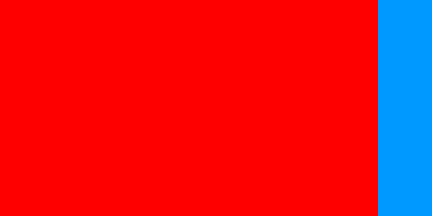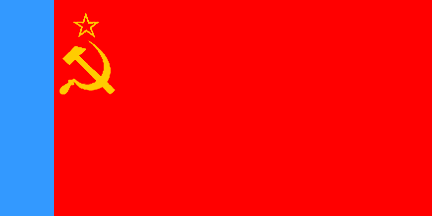
image by António Martins, 07 September 1999 |

FOTW beschäftigt sich mit der Wissenschaft der Vexillologie (Flaggenkunde).
Alle auf dieser Website dargebotenen Abbildungen dienen ausschließlich der Informationsvermittlung im Sinne der Flaggenkunde.
Wir distanziert uns ausdrücklich von allen hierauf dargestellten Symbolen verfassungsfeindlicher Organisationen.
Last modified: 2021-01-09 by rob raeside
Keywords: russia | rsfsr | russian sfsr | hammer and sickle (yellow) |
Links: FOTW homepage |
search |
disclaimer and copyright |
write us |
mirrors
 image by António Martins, 30 October 2003 |
image by António Martins, 30 October 2003 |
See also:
RSFSR — Russian Socialist Federal Soviet Republic (Rossiĭskaâ
Socialistiĉeskaâ Federativnaâ Sovetskaâ Respublika |
Российская
Социалистическая
Федеративная
Советская
Республика).
This was the official “long” name both before and after the set
up of the Soviet Union.
António Martins, 15 January 2000
The flag for the RSFSR was revised in 1954 to contain a bar at the hoist of 1/8 the length of the flag. The constitution of the RSFSR dated April 12, 1978 article 181 states (in pertinent part) as follows:
The state flag of the Russian Soviet Federative Socialist Republic presents itself as a red rectangular sheet with a light-blue stripe at the pole extending all the width [read height] which constitutes one eighth length of the flag.While I am quoting from a later version of the constitution, the bar did not change.
Could the flag of the Commander of Naval
Forces of the Soviet Russian Navy (1921-1924) have been the precursor
for the design of the later RSFSR flag, red with a vertical blue stripe at
the hoist?… I note that the RSFSR was the only SSR
flag only with non-horizontal stripes.
António Martins, 12 March 2000
RSFSR had the only SSR flag with only
non-horizontal stripes, while Byelorussia had the
only one with both.
Steve Stringfellow and António Martins,
12 and 13 March 2000
The Russian flag (white-blue-red) was approved as
National flag in August 1991 by the Supreme Soviet of RSFSR and was used
together with the soviet era flag for a few months until
finally adopted by decree of the Congress of People’s Deputies in
December 1991.
Alexander Getmanenko, 28 May 2003
According Vexilologie 9-10
[vex] there were two patterns for
Russia FSSR: pattern of 1954-1955, and pattern after 1955.
Changes are in the size, position and design of the hammer-and-sickle and star.
Consequently, also the flags of the ASSRs within Russia were
slightly changed in 1955.
Jaume Ollé, 22 July 2001
 image by António Martins, 07 September 1999 | |
No hammer, sickle and star on the
reverse side.
Mark Sensen, 25 May 1997
Officially reverse looked like obverse without star and hammer-sickle.
But in fact I never saw these flags without star, hammer-sickle. Real flags
(all 15) usually were either with reverse analogous
to obverse (but with star and hammer-and-sickle near the hoist) or with
reverse = mirrored obverse.
Victor Lomantsov, 30 November 2002
The photo shows former
Russian president Boris Yeltsin in an speech. Behind him two flags: the
RSFSR flag 1937-1954 (red with Cyrillic
letters "RSFSR") and another one, red with the
former RSFSR coat of arms.
Antonio Gutiérrez, 11 December 2004
The photo shows Boris
Yeltsin at his first Inauguration as President of Russia (still known
then as the Russian Soviet Federated Socialist Republic or RSFSR) on
July 10, 1991. The red flag on the left of the photo is clearly not
the RSFSR flag, nor the Soviet
Flag, nor the Russian tricolor which was not
adopted until the following month. Could it be a presidential flag?
The scarlet red flag appears to have a coat of arms in the center and
gold Cyrillic letters can just be made out on the top of the flag.
Erik Bell, 10 December 2005
This flag is a mystery for Russian
vexillologists too… We saw this flag only one time —
in the Yeltsin’s inauguration. He had no personal flag at that
times. But I think he wanted to use any beautiful standard for
inauguration (not usual flag). I think it was banner
of RSFSR or
banner of Supreme Soviet (supreme council) of RSFSR. I don’t
know why he not used soviet flag of RSFSR
(red with hammer-and-sickle and blue vertical stripe).
Victor Lomantsov, 11 December 2005
I recently picked up a book called "Kodumaa Rikklikud Sumbolid" (Tallinn,
Estonia SSR 1979, published by "Essti Raamat") and this book has a description
of the flag that looks exactly like that
banner behind Yeltsin. For the
Estonian SSR, there is a banner the republic had and
the pattern is like that of the RSFSR flag behind Yeltsin;
the maroon color flag that is 2x3 (fringed) that has the emblem of the republic
in the center (in full color) with the name of the republic, in Russian, above
the emblem in gold. The reverse has a painting of Lenin with "Workers of the
World, Unite!" in Russian in gold closer to the hoist. I provide scans of
these drawings. As for how these banners
are used, that I do not know as of yet, as I still need to study the book.
Zachary Harden, 15 November 2013
 image by Antonio Gutiérrez, M. Schmöger,
Željko Heimer and António Martins, 13 October 2006 |
image by Antonio Gutiérrez, M. Schmöger,
Željko Heimer and António Martins, 13 October 2006 |
Many (all?) soviet republics had these
banners. Usually it was red field with republican
coat-of-arms and the name of republic.
They had gold fringe. Yeltsin’s
mysterious
red banner was may be a sort of banner (colour) of RSFSR.
Victor Lomantsov, 09 January 2002
ru.gif) image by Antonio Gutiérrez,
M. Schmöger and
António Martins, 10 November 2002
image by Antonio Gutiérrez,
M. Schmöger and
António Martins, 10 November 2002
The emblem was introduced on 10 July 1918
(according to Hesmer [hes92]) and
modified several times afterwards (last modification on 12 April 1979).
It was replaced by the current arms on 30 November
1993.
Marcus Schmöger, 16 September 2001
There are no dots after letters in 1978 variant of the emblem.
Victor Lomantsov, 29 November 2002
ru78.gif) image by
M. Schmöger, 09 September 2001
(source: [hzg80])
image by
M. Schmöger, 09 September 2001
(source: [hzg80])
An official soviet handbook publ. 1980
(SSSR — Administrativno-territorialhnoe Delenie Soûznyq Respublik)
shows the emblem with a star, while Herzog
[hzg80], also publ.
1980, shows a starless emblem — just like the
1918 version. I infer that adding the
star was the change (or one of the changes) of 1979 referred to by Hesmer
[hes92].
António Martins, 10 November 2002
On a webpage
dealing with the 15 federal units which composed the soviet Union in its
latest stage (constitution quotes from the 1980 versions), depicting (quite
poorly) the respective flags and arms. The emblem of Russian SFSR is shown
without star (which apparently contradicts this difference being the 1919
change).
António Martins, 29 November 2002
Hosted by: Fanshop-Online.de und Handy-Shop.de
Tipp: Apple iPhone 12 im Shop